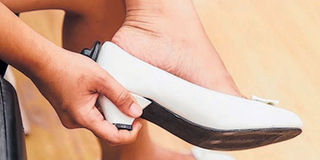Dangers of wearing ill-fitting footwear

Wrong footwear can cause permanent damage to feet leading to deformities such as claw/hammer toes, ingrown toenails, calluses and bunions. Even a short period of time in the wrong type of shoes can aggravate stress and pain to your bones and joints, and the soft tissues that support them leading to foot pain.
According to Dr Quraish Golooba, a physiotherapist, heel pain is one of the most common foot pains. The heel is part of the foot which comprises the back, middle and the front part.
The heel is connected to the calf muscles by the Achilles tendon, which is one of the strongest tendons in the body that support walking and standing.
The middle foot is made of five bones that form the arch of the foot (the curve in the middle of the foot) connected by a ligament called the arch ligament (planta fascia). This part of the foot is very essential for stability and shock absorption when running or walking. The toes form the front part of the foot and they are connected by muscles and ligaments.
“If you experience morning pain when you put down the foot, it is a sign that you have a problem with the Achilles tendon, says Dr Golooba. Pain when walking or standing but resolves upon rest, tenderness under the bottom of the heel bone or the arch of the foot near the ball of the foot and swelling and painful Achilles tendon are signs that you need to consult an orthopeadist or physiotherapist.”
Causes of foot pain
There are complications that can arise from bad foot wear.
Plantar fasciitis
This is inflammation of the planta fascia, the band of tissues that stretches from the heel bone forming five bands that attach to the metatarsal bones. Tightness of the calf area can also cause heel pain, especially in people that wear high heeled shoes for a long time
“Poor weight distribution and shock absorption among people who are overweight and those that have no curve in the middle foot. It commonly occurs among people whose work involves walking for long distances, standing for long hours as well as athletes,” says Dr Abdul Shirazi, a consultant orthopaedist.
Achilles tendonitis
This is the tendon that acts as a joiner between a muscle and bone. It results from over using the tendon especially in the case of athletes. The person starts tiptoeing while walking because there is tightness in the muscles.
Bursitis
This is the reddening and swelling of the heel. A bursa is a fluid filled pad in the joint. When it becomes inflamed, one experiences reddening called bursitis
Risk factors
Bad footwear is a common cause of heel pain among a number of people. Unsupportive foot wear affects the walking and weight distribution patterns of the body, which in turn results into Achilles tendonitis.
Dr Golooba says, “Good footwear should neither be too thick nor too thin and rough when you put it on. High heels are also discouraged for better foot care. The shoes should correspond to the activity that is going to be undertaken. They must be well fitting and should have good treads that can go against friction and supportive enough to absorb pressure.”
Obesity and being overweight affects weight distribution in the foot. When there is too much weight, there will be a lot of pressure exerted on the foot leading to inflammation thereby irritating the foot. Repetitive exercises in runners and long distance walkers and stress fractures are also risk factors for heel pain.
Treatment
When you have any of the above pains, Dr Golooba recommends that you have it treated first at home with ice. Leave the ice pack on the affected area for about 20 minutes three or four times a day.
This will help to relieve the inflammation. In case of pain, have the pain investigated by a physiotherapist since some people may be allergic to ice and experience an ice burn.
“Not all heel pains are likely to result into surgery. It is, therefore, important that you consult an orthopeadic surgeon to determine the extent of the damage and recommend necessary treatment,” Dr Shirazi remarks. Before you leave your bed, do stretches to relieve the pain in the Achilles tendon and planta fascia and increase flexibility. Add stretching of the calf muscles as part of the war map for exercises and running.
Dr Shirazi advises stretching exercises such As swimming are also good. Also, try to walk especially if the pain is bearable. Bed rest is only recommended for severe acute pain.




